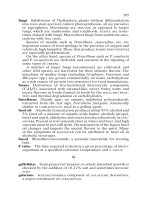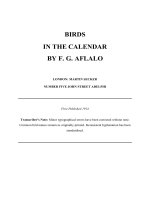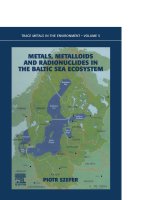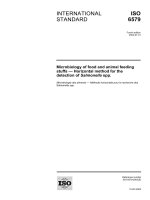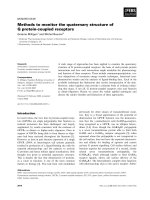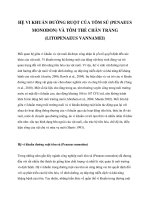The Aral Sea Encyclopedia - G doc
Bạn đang xem bản rút gọn của tài liệu. Xem và tải ngay bản đầy đủ của tài liệu tại đây (324.6 KB, 6 trang )
G
Geller Samuil Yulievich (Yevelievich) (1906–1972) – Soviet geographer who was
one of the pioneer researchers studying the Karakum Desert. He graduated
from the Geographical Department of Leningrad University, Doctor of Geo-
graphy (1947). In the 1920s, he took part in the expeditions led by A.Ye.
Fersman and D.I. Scherbakov. Their investigations focused mainly on desert
geography and saline water desalinization. In 1930, the USSR Academy of
Sciences (USSR AS) sent G. to investigate the western part of the Northern
Karakums, after which he worked in the Kara-Bogaz-Gol area, then studied the
Southern Mangyshlak Plateau, the Karyn-Djaryk depression, and Ustyurt. As
a result, G. developed his theories about the utilization of deep drainless
depressions for hydropower generation and raw chemical materials production.
In 1934, together with V.N. Kunin, he published a review of the projects on
watering of the Turkmen Karakums. Here, he drew attention to the utilization
of Kelif Uzboy for transit of the Amudarya waters to the west.
His hydrological studies of deserts resulted in the formulation of an engi-
neering-geographical practical proposal on deriving fresh waters from saline
water by their natural freezing. G. built a trial site on which saline water was
frozen in a layer-by-layer mode over a winter. At freezing, salts in the form of
brine precipitate from ice that after subsequent thawing becomes fresh water.
In his work, ‘‘Some Aspects of the Aral Sea Problems’’ (1969), G. disagreed
with those who advocated for the calculation of an optimal water level in the
Aral. Relying upon economic estimates, G. argued that the benefits from
expansion of irrigated farming would outstrip by 100-fold losse s due to degra-
dation and the interruption of the fishery activities that were the key economic
sector for this water body.
Considering the effects of wind drift of salts from the drying Aral Sea, the
stock of which is evaluated at 10 bill tons, G. comes to the conclusion that ‘‘wind
drift of salts precipitated from waters of the Aral Sea is not hazardous for the
irrigated lands of Central Asia and Kazakhs tan because only calcium salts and
quite insignificant quantities of sodium sulfates may be transferred by wind.’’
G. proposed using a part of the dried out sea for irrigated farm ing.
During his last years, G. devoted much time to the problems of the Cas pian
Sea in view of a steady drop of the sea level.
I.S. Zonn et al., The Aral Sea Encyclopedia, DOI 10.1007/978-3-540-85088-5_8,
Ó Springer-Verlag Berlin Heidelberg 2009
99
At the Institute of Geography of the USSR Academy of Sciences, G. headed
research on likely changes in the physiographical conditions in the A.S. basin
due to construction of the Karakum canal. Unfortunately, a comprehensive
summary devoted to this problem was published only after his death.
Since 1956, G. was a member of the editorial board of the journal ‘‘Proceed-
ings of USSR AS. Geographical Series.’’ For several years, he headed the
editorial board on geography of the Foreign Literature Publishers in M oscow.
Geology of the Aral Sea – monograph by I.V. Rubanov, D.P. Ishniyazov,
M.A. Baskakov, and P.A. Chistyakov published in Tashkent in 1987. It describes
the geological structure and history of the Aral depression; provides data on
stratigraphy and lithology of the Paleogene, Neogene, and Quaternary depos-
its in the Circum-Aral area and in the Aral depression; details bottom and
beach sediments and also the delta deposits of the Amudarya and Syrdarya;
and studies the issues of Holocene and modern lithogenesis. The book studies
the lithology and salinity level of deposits f ormed as a result of the disastrous
drop of the sea level as well as scales of ground deflation due to drying out and
desertification of the Circum-Aral territory. Brief information is given about
mineral deposits of the region.
Glazovsky Nikita Fedorovich (1946–2005) – well-known scientist, geographer,
geologist and ecologist. From 2001, he was a Corresponding Member of the
Russian Academy of Sciences (RAS). In 1964, he grad uated from the Geologi-
cal Department of the M.V. Lomonosov Moscow State University (MSU)
which was also his first place of work; here, he defended his candidate (in
1972) and doctoral (in 1985) academic theses. Worked at MSU and RAS
Institute of Soil Science and Photosynthesis. From 1988 and until his death,
he was deputy director of the RAS Institute of Geography. In his scientific and
organizational activities, apart from fundamental investigations in physical
geography and the geochemistry of landscape, G. paid much attention to the
problems of arid territories in Central Asia. Many times, G. went on the
centerboard boat ‘‘Mega’’ over the Aral. In 1980, he published his monograph
‘‘Aral Crisis’’ (see), which suggested a solution of the A.S. problem. Quicker
accession of the Russian Federation to the UN Convention on Desertification
Control and Alleviation of Draughts may be credited to Glazovsky. In 1995, he
became a direct or of the Regional International Program, ‘‘Leaders in Envir-
onment and Development,’’ and he energetically engaged young Central Asian
specialists and scientists in activities of this creditable organization. G. was
awarded the Silver (IInd degree) Medal ‘‘For Russian Nature Conservation’’
and the Honorary Diploma of Russian Environmental Movement ‘‘Green’’
‘‘For Environmental Educa tion Development in the Russian Federation.’’
For a long time, G. was an active member of the editorial board of the inter-
national scientific-practical journal, ‘‘Desert Development Problems.’’
G. is the author of a concept on a conjugate analysis of matter migration in
the Earth’s landscape shell. He determined the correlation of regional matter
flows in the biosphere, defined specific features of the biogeochemical cycle in
100 G Geology of the Aral Sea
various natural zones, and identified salt balances in some arid regions and
landlocked seas. G. introduced new notions of technogenesis geochemistry, and
developed an original methodology and estimated the technogenous geochem-
ical load on the biosphere and its particular regions. He also made a compara-
tive assessment of the efficiency of natural resource management in the world
and elaborated proposals on the improvement of various nature management
mechanisms. G. supervised the process and directly took part in preparation of
ecological maps for Russia and other countries; he also proposed a classifica-
tion of environmental situations based on a conjugated analysis of the states
and dynamics of nature, population health, and economics and social relations.
In the 1980s, he was one of the initiators of the State Environmental
Expertise, and after its establishment, he became a member of the Board of
the RSFSR State Environmental Expertise. After 1990, he was chairman of the
nature management section of the Higher Environmental Council at the State
Duma of Russia.
In 1991–1992, G. was Deputy Minister of Ecology of the Russian Federa-
tion, and in 1991–2000, he was a member of the board and scientific-technical
council of the Ministry of Ecology and State Committee for Ecology. In
1992–1994, he was a member of the Council on Critical Situations and Analysis
of Governmental Decisions for the President of the Russian Federation.
In 199 7–2000, he was elected the Chairman of the Board of the Federal
Ecological Fund of the Russian Federation, and in 2004, he became Chairman
of the Trust Board of the Russian Foundation for Wild Nature Protection.
G. was actively involved in international activities addressing the problems of
nature conservation and sustainable development. He was a research manager
of the USSR-UNEP Projects ‘‘Reclamation of Saline Irrigated Lands’’ and the
Russia-UNEP project on desertification control, the UNEP expert on the
project ‘‘Agriculture Impacts on the Natural Environment,’’ and a UNEP
consultant on desertification issues. In the period 1989–1997, he was a member
of the Advisory Board of the World Resources Institute (Washington). In
1990–1994, he represented Russia at the Interstate Council on the Aral Sea
Fig. 31 N.F. Glazovsky
(1946–2005)
Glazovsky Nikita Fedorovich (1946–2005) G 101
Basin Problems. In 2000, he was elected, and in 2004, re-elected the Vice
President of the International Geographical Union. He was a member of
editorial boards of various Russian and foreign journals addressing environ-
mental protection issue s. G. was a Fellow of the Environment Academy (1994)
and a Fellow of the Natural Science Academy (1996). In 1996, he was awarded
the title ‘‘Honored Ecologist of the Russian Federation.’’
Global Environment Facility (GEF) – established in 1991 as a grants program
aimed at financially supporting the implementation by developing countries of
commitments made under international agreem ents on environment protec-
tion. The GEF also sponsors activities on the implementation of the Conven-
tion on Climate Change and the Convention on Biological Diversity adopted in
1992 in Rio de Janeiro at the UN Conference on Environment and Devel op-
ment. GEF activities are supervised by the World Bank, UNDP, and UNEP.
GEF actively participates in financing the Aral international projects.
Grass carp (C. idella (Valenciennes) – the introduced fish belonging to
Ctenopharyngodon (Steindachner) genus, carp family (Cyprinidae). It was
brought here in the early 1960s from China and let go into the sea and rivers.
Its body length is up to 120 cm, and its weigh t is up to 30 kg. It prefers living in
arms and lakes. It reaches maturity at 7–8 years, reaching a length of 65–70 cm.
Spawning is fractional in June-July and at water temperature of 26–308C. Eggs
are pelagic, spawning occurring during water level rise. The fertility rate is
29–816 thou eggs. Larvae are carried into the coastal zone where they feed on
zooplankton and algae. In spring, full-grown fish migrate to floodplains and
lakes where they feed extensively (they are voracious) on water plants and on-
land immersed soft vegetation. It was recommended to use this attribute of G.C.
for biological cleaning of canals and headers. It is acclimatized to Central Asia.
It is widely used in pond farming and acclimatization. In 1960, G.C. was let go
into the Karakum Canal where it naturalized well and populated the canal and
the Amudarya River.
Greater Amudarya Shovel-Nosed Sturgeon (Pseudoscaphirhynchus kaufmanni) –
fish of the Sturgeon family (Acipenseridae). At the end of the snout it has from 1
Fig. 32 Grass carp (or
White Amur) (C. idella
(Valenciennes)
102 G Global Environment Facility (GEF)
to 9 sharp thorns; 2 sharp thorns are also found both between the eyes and at the
occiput. The upper blade of the caudal fin ends with a long filament. It has 10–15
dorsal bony plates, 28–40 lateral plates, and 5–11 pelvic bony plates. The body
between the bony plates is covered with bony grains. The mouth is large. The eyes
are very small. The length (without caudal filament) is up to 60 cm, and the weight
is up to 1 kg. It lives in the fresh waters of rivers with sandy bottoms. It reaches
maturity at the age of 6–7 years (males) and 7–8 years (females), having a length
about 25 cm. The spawning period is April. Fertility is 1000–1900 eggs,
1.9–2.4 mm in diameter. The largest specimens lay up to 37 thousand eggs.
After hatching, the fries move downstream, and feed on aqueous larvae of insects,
eggs, and fish fries. Specimens older than 10 years are met quite seldom. Lives
mostly in the Amudarya. A valuable fish species; due to its low population,
however, it has no commercial significance. It is also found in the Mississippi
River (USA).
Greater and Smaller Barsuki sands – sandy deserts extending meri dionally as
two long and narrow strips from A.S. and divided by the parent relief band.
G.B. is approximately 200 km long, while S.B. is about 100 km long. Their
elevations reach 100 m. In some localities, the sands are deflated, forming
hummocks, ridges, and barkhans. The vegetation is not uniform here: on
flattened terrains, xerophytic shrubs, wormwood, thistle, and ephemers prevail,
while the slopes of hummocks and ridges are covered with the thickets of
calligonum, sandhill wattle, milk vetch, kundym, and salt trees.
Greater Chushka Island
*
– located near the eastern coast of A.S. It is one of the
islands that cover the Aksaga Bay (see) on the west. The island is low and sandy,
and its elevations vary from 1 to 3 m.
Greater Sarychaganak, Sarychabanak Bay
*
– located in the northeast of A.S.
The bay is large. The depths in the center reach 12–13 m. Two kinds of currents
are observed: the southwestern current generated by north and northeastern
winds and the northeastern current. Severe wind-generated water-level fluctua-
tions are recorded in the bay, with range reaching 3 m. They are generated
largely by the southern, southwestern, and western winds.
Fig. 33 Greater Amudarya
shovel-nosed sturgeon
(Pseudoscaphirhynchus
kaufmanni)
Greater Sarychaganak, Sarychabanak Bay G 103
Greater Sudochie Lake – a part of the water-marshy lands of Sudochie Lake
(see), composing ap proximately 22.4% of their total area. The lake area is 98 sq.
km, its maximum length reaches 10 km, and it has a width of 4.5 km. Its depth
does not exceed 1.0–1.2 m, and its coastline is 32 km long. During the disastrous
low-water period in 2000–2001, the lake dried out completely.
104 G Greater Sudochie Lake

